Andrew Paul Wood – 22 June, 2016
Of course it is in the nature of a Cullen installation that functionality always just sabotages itself. The equipment is often unplugged, or deliberately out of alignment, or otherwise unusable and purposeless in a celebration of frustration, the disjointed, and the incomplete, but much like the installations of Joseph Beuys the abjection hints at the possibility of transition, change and evolution. Things can potentially be fixed or plugged in, and sometimes they are.
I do not mean the human world of our relations and friends: to enlarge on that is the province of nearly every modern novelist. In their books it is called ‘Life’ and an odd enough hash it is as they portray it. No, it is the world of things that do not speak or work or hold congresses and conferences.
-M.R. James, “The Malice of Inanimate Objects” (1933)
And I have seen dust from the walls of institutions,
Finer than flour, alive, more dangerous than silica,
Sift, almost invisible, through long afternoons of tedium,
Dropping a fine film on nails and delicate eyebrows,
Glazing the pale hair, the duplicate grey standard faces.
-Theodore Roethke, “Dolor” (1948)
Paul Cullen‘s Provisional Arrangements is a difficult installation to tidily nail down, simply because of its very nature. The concept was developed with Allan Smith, curator and lecturer at Elam. (Cullen teaches at AUT.) That’s straightforward enough. The starting point is an image of the eroded traces of a 50,000 year old meteorite impact crater, an astrobleme, in Odessa, West Texas in the US - the second largest such crater in the world. Thenceforth it becomes more complicated.
Cullen’s installation is underpinned by ‘Pataphysics - the science of “imaginary solutions” as Alfred Jarry called it, often to non-existent problems. ‘Pataphysics (the inverted comma is traditional to avoid a pun in French that probably doesn’t exist) is the philosophy of speculating on what is itself speculative, the tail growing a new lizard. It lies beyond the metaphysical fields we know, but is a lot more conscious and deliberate than surrealism.
The Odessa Meteor Crater lends itself rather well to the game, since knowledge of its existence is largely a matter of inductive research and speculation. In part the on-going work is a quasi-Situationalist response to Cullen having visited the site in 2012 when Senior Fulbright fellow at Auburn University in Alabama. The installation itself, however, is a movable feast of polymorphic perversity - a conceptual spatial drawing in Duchampian objets trouvés now at many removes from the crater in a game of ‘Chinese Whispers’ with itself.
The gallery space gives the impression of having been set up as some kind of minimalist teaching laboratory, perhaps riffing off its white walls and the university campus location. There is too, perhaps, a suggestion of the artist’s botanical training. He likes to play with the tropes of experimentation and the scientific method. The crater is an almost incidental presence as large, sepia-tone (the colour of the desert) prints of aerial survey photographs, one on the floor and two mounted on the wall as if ready for a lecture. The theme of the laboratory seems a deliberate counterpoint to the nature of an art gallery, for while exhibition spaces often position themselves and places of investigation and experimentation, more often than not they are passive and mediated.
There are inscrutable, anonymous-looking things on metal shelves or propped against walls. Black and white surveyors’ levels lie down the middle of the floor, dividing it in two. Improvised plastic sheet containment barriers form the backdrop to tables where buckets sunk crater-like into the table tops sustain cacti-forms in allusion to the desert location. An illuminable lunar globe, likewise sunk into a table top continues the themes of craters and space. Books, rendered unreadable by being impaled on a rod, are simultaneously a pedestal for that rod. A large, sometimes squashed dodecahedron in metal foil suggests a possible crashed satellite or alien spacecraft (Roswell is about 320 km from Odessa, in New Mexico).
Various components have recognisably been recycled from other Cullen installations. Of course it is in the nature of a Cullen installation that functionality always just sabotages itself. The equipment is often unplugged, or deliberately out of alignment, or otherwise unusable and purposeless in a celebration of frustration, the disjointed, and the incomplete, but much like the installations of Joseph Beuys the abjection hints at the possibility of transition, change and evolution. Things can potentially be fixed or plugged in, and sometimes they are.
While the actual components of the installation more or less stay where they are discovered, they have moving parts or go through minor transformations, are plugged in, raised or lowered. Elements are seconded into inferring physical relationships between objects and volumes: linking or dividing them. At the risk of sounding obnoxiously gnomic with art world waffle, this emphasises their ‘objectness’ and ‘volumeness’ through absurd conjunctions and cartoonishly precarious supports, as the artist sets up and short-circuits their taxonomy and syntax. They are suggestive, but an actual Rosetta Stone of meaning remains tantalisingly out of reach. Not that the objects care; they are too busy being present.
This is the seeming opposite of the maximalist, full tilt approach of the gallery space’s previous tenant, Dan Arps (though they share the absurd conjunctions and feigned vulnerability), but has a lot in common and some visual similarities with the scaled-back Clayton’s heroic-sublime spirit of Robert Hood. Both, I would suggest, are natural heirs. I think, too, there’s an ongoing convergent and complementary conversation with et al’s work, though Cullen is very much about psychogeography where et al’s monuments to failed utopias and frustrated visions are more anchored in abstract social and ideological frameworks.
I tend to think of Cullen as a sort of Postmodern Romantic. There is a strong sense of paradoxical Lyotardian Sublime, that beyond all this is something impossible to present, which nonetheless, demands to be rationalised and made sensible, yet overwhelms any attempt to do so. Modernism tried to represent that by replacing the missing unknowable with aesthetic formalism. Cullen, in the Postmodern spirit, presents the unknowable as an unvarnished truth, letting that absence speak for itself. As the Wittgenstein aphorism runs, whereof we cannot speak, thereof we must remain silent - and Richard Rorty tells us not to worry because it doesn’t matter.
Ultimately it’s a sort of Ozymandias moment. If even vast craters hammered into the earth by meteorites from space are ultimately ephemeral, how vain and futile is the desire to measure, record and understand them?
Andrew Paul Wood
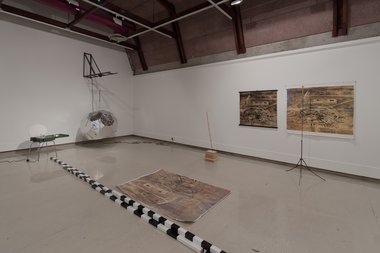
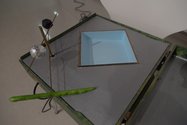
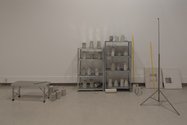
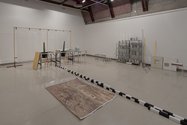

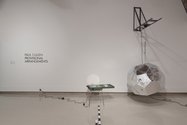
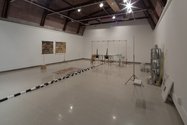
 Advertising in this column
Advertising in this column Two Rooms presents a program of residencies and projects
Two Rooms presents a program of residencies and projects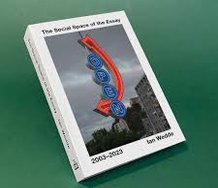


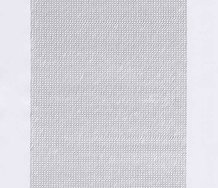
This Discussion has 0 comments.
Comment
Participate
Register to Participate.
Sign in
Sign in to an existing account.